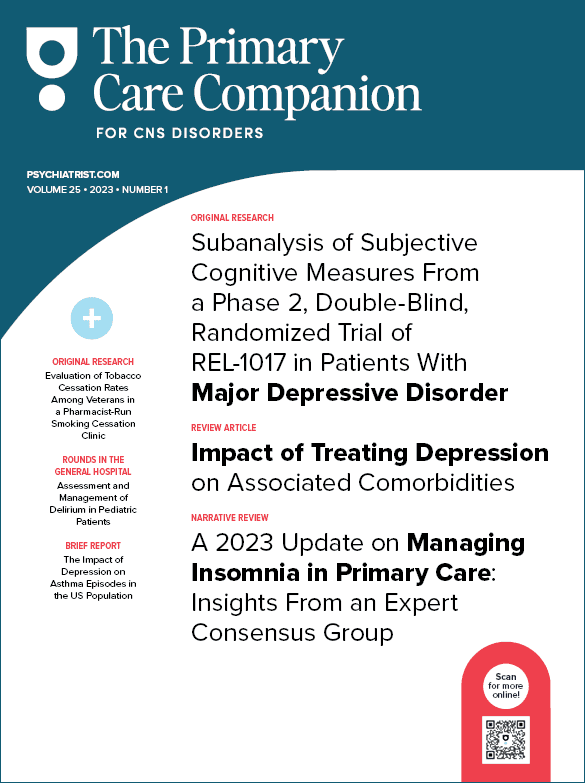
Prim Care Companion CNS Disord 2022;24(1):21cr02925
To cite: Benjelloun R, Aasfara J, Otheman Y. Management of acute insomnia and anxiety in a patient with myasthenia gravis and respiratory failure. Prim Care Companion CNS Disord. 2022;24(1):21cr02925.
To share: https://doi.org/10.4088/PCC.21cr02925
© Copyright 2022 Physicians Postgraduate Press, Inc.
aDepartment of Psychiatry, Faculty of Medicine, Mohammed VI University of Health Sciences, Casablanca, Morocco
bDepartment of Neurology, Faculty of Medicine, Mohammed VI University of Health Sciences, Casablanca, Morocco
cDepartment of Psychiatry, Faculty of Medicine and Pharmacy, Sidi Mohamed Ben Abdellah University, Fez, Morocco
*Corresponding author: Yassine Otheman, MD, Moulay Ismail Military Hospital, postal code: 50000, Meknes, Morocco ([email protected]) (ORCID-ID: 0000-0003-1056-454X).
Myasthenia gravis (MG) is one of the rare contraindications of anxiolytics and hypnotics. At the same time, anxiety and insomnia are frequently observed in severe forms of MG.1 In the context of severe respiratory symptoms or respiratory failure, management of acute insomnia and anxiety is a therapeutic challenge with limited pharmacologic options.
Case Report
A 40-year-old woman, with no psychiatric history but previously diagnosed with generalized MG, presented to the emergency department 18 days after she delivered her first child with fatigue, diplopia, unilateral ptosis, progressive shortness of breath, and swallowing difficulties. She had her first episode of cardiorespiratory arrest during a computed tomography angiography procedure and was placed under endotracheal intubation and ventilation. She was diagnosed with myasthenia crisis. Initial treatment consisted of intravenous immunoglobulins (2 g/kg over 5 days) with prednisone (20 mg/d) and pyridostigmine (30 mg 3 times/d). Her condition did not improve, and she could not maintain spontaneous breathing. She subsequently underwent extubation and reintubation procedures 3 times. She finally responded after 5 sessions of plasmapheresis. She maintained spontaneous breathing after extubation 72 hours after the last session.
The patient spent 29 days in the intensive care unit. Five days after the failure of the first extubation attempt, she exhibited insomnia, acute anxiety, sensation of imminent death, and recurrent tachycardia. She did not meet DSM-5 criteria for posttraumatic stress disorder (PTSD), postpartum depression, or postpartum psychosis. We concluded that she was experiencing panic attacks triggered by the worsening of the respiratory condition, with anticipatory anxiety about being short of breath. Therefore, she was given mianserin at an initial dose of 15 mg/d. She experienced no adverse effects and a partial response: only sleep was improved. After augmentation to 30 mg/d, the frequency and intensity of the panic attacks decreased, allowing for extubation, and mianserin was tapered and stopped at the request of the patient after she left the intensive care unit. She was transferred to the neurology ward and stayed for 10 days and then left the hospital. After being discharged, the patient maintained regular follow-up with her neurologist.
Discussion
Psychiatric comorbidities in patients with MG are rarely studied. They usually consist of anxiety disorders such as panic disorder and generalized anxiety disorder and depressive disorders.2 PTSD is also observed after respiratory insufficiency in patients with MG.3 All these psychiatric disturbances are usually associated with sleep problems. Anxiety in patients on respiratory assistance can be particularly problematic and may be related to fear of suffocation and reluctance to be extubated.4 Management of such symptoms may be challenging for practitioners given the constraints that MG presents with anxiolytics and hypnotics (Z-drugs).5
In this case, it was necessary to control the patient’s anxiety symptoms to relieve her distress and to give extubation attempts the maximum chance for success. MG is known to be an absolute contraindication to benzodiazepines and nonbenzodiazepine anxiolytics such as hypnotics, which constitute the first-line treatment for acute and severe insomnia and anxiety. Sedative antipsychotics are the second option but were not used since the patient was still monitored and treated for cardiac rhythm disorders, which also may constitute a contraindication to antipsychotics. Moreover, antipsychotics were also incriminated in worsening of MG and may be confusing to use in this context since myasthenic crisis may be mistaken for antipsychotic-induced extrapyramidal syndromes.6,7
Among few other pharmacologic options remaining, mirtazapine and mianserin are atypical tetracyclic antidepressants used off-label for insomnia and acute anxiety, given their histamine H1 receptor blocker activity with almost no anticholinergic effects.8–10 Cognitive-behavioral therapy can also be implemented to manage anxiety symptoms in patients with MG, either as a monotherapy or as an adjuvant to pharmacologic treatment.11
Postpartum patients may be at increased risk of MG onset and recurrence.12,13 Therefore, further pregnancies must be carefully planned and managed to decrease the intensity of potential postpartum symptoms.
This case suggests that mianserin appears to be a therapeutic option to consider for symptoms of anxiety and insomnia in myasthenic patients under respiratory assistance. However, in the absence of literature on the subject, further studies and other clinical observations are needed to evaluate the role of mianserin in such indications.
Published online: January 27, 2022.
Potential conflicts of interest: None.
Funding/support: None.
Patient consent: Written consent was obtained from the patient to publish the case report, and information has been de-identified to protect anonymity.
References (13)

- Hoffmann S, Ramm J, Grittner U, et al. Fatigue in myasthenia gravis: risk factors and impact on quality of life. Brain Behav. 2016;6(10):e00538. PubMed CrossRef
- Kulaksizoglu IB. Mood and anxiety disorders in patients with myasthenia gravis: aetiology, diagnosis and treatment. CNS Drugs. 2007;21(6):473–481. PubMed CrossRef
- Liu C, Li T, Wang Q, et al. Posttraumatic stress disorder symptoms after respiratory insufficiency in patients with myasthenia gravis. Psychol Health Med. 2021;26(2):221–227. PubMed
- Dupuis S, Brindamour D, Karzon S, et al. A systematic review of interventions to facilitate extubation in patients difficult-to-wean due to delirium, agitation, or anxiety and a meta-analysis of the effect of dexmedetomidine. Can J Anaesth. 2019;66(3):318–327. PubMed CrossRef
- Jordan H, Ortiz N. Management of insomnia and anxiety in myasthenia gravis. J Neuropsychiatry Clin Neurosci. 2019;31(4):386–391. PubMed CrossRef
- She S, Yi W, Zhang B, et al. Worsening of myasthenia gravis after administration of antipsychotics for treatment of schizophrenia: a case report and review of literature. J Clin Psychopharmacol. 2017;37(5):620–622. PubMed CrossRef
- Chiu YH, Yang AC, Chern CH, et al. Myasthenic crisis may mimic antipsychotic-induced extrapyramidal syndromes. J Neuropsychiatry Clin Neurosci. 2011;23(2):E36–E37. PubMed CrossRef
- Rihmer Z, Purebl G. Mirtazapine–pharmacologic action and clinical advantages. Neuropsychopharmacol Hung. 2009;11(1):35–40. PubMed
- Al-Majed A, Bakheit AH, Alharbi RM, et al. Mirtazapine. Profiles Drug Subst Excip Relat Methodol. 2018;43:209–254. PubMed CrossRef
- Mayers AG, Baldwin DS. Antidepressants and their effect on sleep. Hum Psychopharmacol. 2005;20(8):533–559. PubMed CrossRef
- Chand SP, Kaminski HJ. Cognitive-behavioral therapy for psychiatric comorbidity in a case of muscle-specific kinase-positive myasthenia gravis. Prim Care Companion CNS Disord. 2017;19(5):17l02103. PubMed CrossRef
- Boldingh MI, Maniaol AH, Brunborg C, et al. Increased risk for clinical onset of myasthenia gravis during the postpartum period. Neurology. 2016;87(20):2139–2145. PubMed CrossRef
- Piccioni MG, Tabacco S, Giannini A, et al. Myasthaenia gravis in pregnancy, delivery and newborn. Minerva Ginecol. 2020;72(1):30–35. PubMed CrossRef
Enjoy free PDF downloads as part of your membership!
Save
Cite
Advertisement
GAM ID: sidebar-top




